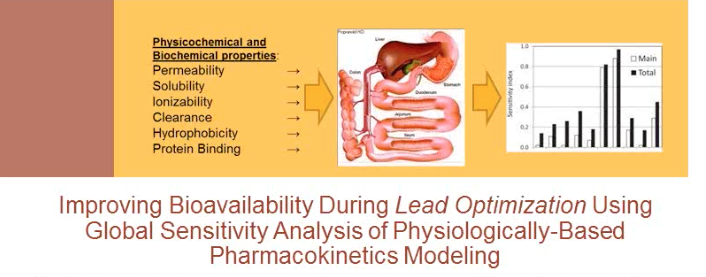
Improving genetic programming for the prediction of pharmacokinetic parameters
The prediction of pharmacokinetic parameters is a crucial phase of the drug discovery process, and the automatization of this task is a hot topic in computational bio-medicine.

Simulations Plus Adds to Portfolio with Release of MembranePlus
First Release of New Product in 10 Years; Provides Unique In Vitro Permeability Capabilities and Creates Cross-Selling Opportunities

Development of nanocrystal formulation of meloxicam with improved dissolution and pharmacokinetic behaviors
The present study aimed to develop nanocrystal formulations of meloxicam (MEL) in order to enhance its biopharmaceutical properties and provide a rapid onset of action. Nanocrystal formulations were...

Systems Pharmacology Modeling Predicts Hepatotoxic Potential Of Troglitazone And Pioglitazone
Troglitazone (TGZ) caused life-threatening drug-induced liver injury (DILI) in diabetic patients, whereas the next in class, pioglitazone (PGZ), has rarely been associated with DILI. Inhibition of bile acid...

Improving Bioavailability During Lead Optimization
In this presentation, Dr. Eric Martin of Novartis discusses improving bioavailability during lead optimization using global sensitivity analysis (GSA) of physiologically based pharmacokinetics.

Synthesis of a novel universal opioid receptor agonist with the 1,3,5-trioxazatriquinane skeleton and its pharmacologies
We designed and synthesized of 1,3,5-trioxazatriquinanes with o- or p-hydroxyphenyl rings as analogs of the κ opioid receptor agonist SYK-146 with m-hydroxyphenyl groups.

Biopharmaceutical profiling of new antitumor pyrazole derivatives
Several new pyrazole derivatives have demonstrated promising antiproliferative and cytotoxic effects, but their poor solubility raised concerns over possible biopharmaceutical limitations.

Pharma of the Future Historical Timeline
View our milestones.

History of Pharma of the Future
Pharmacometric modeling and simulation has moved from its infancy as a novel way of approaching the analysis of clinical pharmacokinetic data to become an invaluable tool in pharmaceutical and biotechnology research and development.

Pazopanib as third line therapy for metastatic renal cell carcinoma: clinical efficacy and temporal analysis of cytokine profile
Purpose: Pazopanib has been assessed primarily in cytokine refractory or treatment naïve patients with metastatic renal cell carcinoma. Outcomes have been associated...

Model-Based Bioequivalence assessment of a commercial Azithromycin Capsule against Pfizer Zithromax® Tablet marketed in Jamaica
Clinical evidence indicated that effective substitution of azithromycin capsule with a tablet dosage form should be based on evidence of providing equivalent in vivo AUC/MIC ratio at the site of infection.

Isoxazolotacrines as non-toxic and selective butyrylcholinesterase inhibitors for Alzheimer’s disease
Owing to the complex nature of Alzheimer's disease, there is a renewed and growing search for multitarget non-toxictacrines as simple, easily available drugs in order to stop the progress and development of the disease.

PEGylated cyclodextrins as novel siRNA nanosystems: Correlations between polyethylene glycol length and nanoparticle stability
Silencing disease-related genes in the central nervous system (CNS) using short interfering RNA (siRNA) holds great promise for treating neurological disorders.

In vitro – in silico – in vivo drug absorption model development based on mechanistic gastrointestinal simulation and artificial neural networks: Nifedipine osmotic release tablets case study
In vitro--in vivo correlations (IVIVC) are generally accepted as a valuable tool in modified release formulation development aimed at (i) quantifying the in vivo drug delivery profile and...

The acute effects of daily nicotine intake on heart rate – A toxicokinetic and toxicodynamic modelling study
Joint physiologically-based toxicokinetic and toxicodynamic (PBTK/TD) modelling was applied to simulate concentration-time profiles of nicotine, a well-known stimulant, in the human body following single and repeated dosing.

Pharmacokinetics of Paracetamol in Göttingen Minipigs: In Vivo Studies and Modeling to Elucidate Physiological Determinants of Absorption
Onset and rate of gastric emptying are important determinants of drug absorption after oral dosing.

Viscosity-mediated negative food effect on oral absorption of poorly-permeable drugs with an absorption window in the proximal intestine: In vitro experimental simulation and computational verification
Concomitant food intake can diminish oral absorption of drugs with limited permeability and an absorption window in the proximal intestine, due to viscosity-mediated decrease in dosage form disintegration time and drug dissolution rate.

Detection and phenotyping of circulating tumor cells in high-risk localized prostate cancer
Background: In this study, we aimed to determine the feasibility of identifying CTCs in patients with HRLPC, using a modified isolation procedure using the CellSearch...

Eslicarbazepine and the enhancement of slow inactivation of voltage-gated sodium channels: A comparison with carbamazepine, oxcarbazepine and lacosamide
This study aimed at evaluating the effects of eslicarbazepine, carbamazepine (CBZ), oxcarbazepine (OXC) and lacosamide (LCM) on the fast and slow inactivated states of voltage-gated sodium channels (VGSC).
